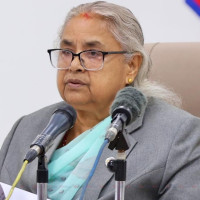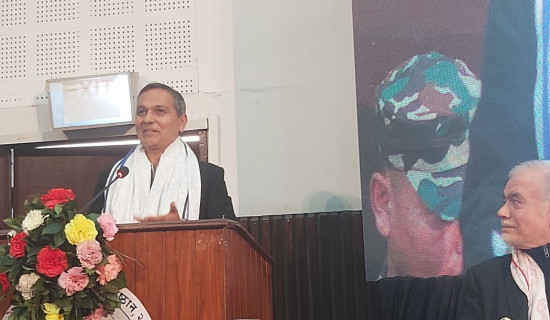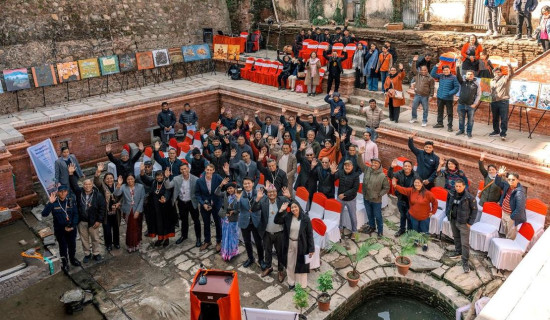- Monday, 8 December 2025
Gen Z Turns Screens Into Streets
On September 9, Kathmandu resembled a scene from Game of Thrones—a spectacle of defiance choreographed through screens. Young protesters flooded the streets, fuelled by hashtags and livestreams, turning frustration into performance. What began as outrage quickly evolved into a collective awakening: a generation no longer content to scroll through injustice but determined to rewrite it.
This was not just another political moment. It was a cultural and psychological rupture—the birth of a new human condition. The Gen Z uprising in Nepal reflects what Yuval Noah Harari calls the transformation from Homo sapiens to Homo deus: human beings shaped not by nature or tradition but by algorithms, digital visibility, and technological mythmaking.
Violence romanticism
The scenes that unfolded echoed the “violence romanticism” that dominates global media. From Game of Thrones to TikTok reels, violence today is not merely condemned or feared—it is performed, aestheticised, even adored. Pain becomes a spectacle, and rebellion becomes entertainment.
During my research, I met a young man who had become addicted to online battle games. His obsession with virtual combat blurred into substance use, and eventually, despair. Meanwhile, war veterans I interviewed spoke of their desensitisation to violence—ready to fight again if “the nation demanded it.” Families of the war’s victims, in contrast, feared even the thought of renewed conflict. The difference lay in proximity and exposure: those who imagined war romanticised it; those who lived it never wished it upon anyone again.
Our visual culture now sustains that same paradox. Through film, gaming, and social media, humans absorb violence as beauty. What Plato feared about imitation in art—its ability to distort moral reality—has become our daily diet of distraction. We celebrate living in an age of free expression, but this freedom conceals a deep irony—the fallacy of communication. The more we communicate, the less we understand. In a world flooded with unfiltered information, expression replaces reflection, and speech replaces meaning.
Western societies once built communication around ethics and intent—from the First Amendment’s “temple of democracy” in the U.S. to Britain’s historic fight for a “free marketplace of ideas.” But deregulation under Thatcher and the rise of global media empires blurred that moral anchor. Technology democratised voices, yet stripped them of depth.
In Nepal, we inherited this digital freedom without the filter of media literacy. Algorithms now curate outrage as efficiently as they curate entertainment. Platforms meant for connection have become battlegrounds of dopamine and disinformation. We are a generation communicating endlessly—but seldom listening. The tragedy of a young woman self-immolating in front of a recording studio exposed a chilling truth about our digital age. Before such acts manifest, they incubate as thoughts—thoughts introduced, processed, and validated in online echo chambers. The internet rewards extremes: the louder the pain, the higher the views.
This is violence romanticism’s final stage—where the line between seeking justice and seeking attention collapses. The economy of attention has turned human suffering into social currency. As Paulo Coelho observed, we crave stories of pain because they make us feel alive. Today, those stories are livestreamed, liked, and monetised. What Nepal faces today is not an epistemic crisis of knowledge or an ontological crisis of being—it is an axiological crisis of values. The ethics of communication have eroded under the aesthetics of expression. People reveal their wounds not as acts of healing but as performances for validation.
This disorder is not unique to Nepal—it is a civilizational issue. The Mesopotamian and Indus Valley civilizations once collapsed not merely from ecological decline but from an imbalance between human innovation and moral restraint. Our fascination with technology risks repeating that mistake. The fallacy of communication lies in believing that connectivity ensures community; in truth, it often dismantles it. The Gen Z uprising marks both hope and hazard. The power to mobilise millions in hours reflects the force of digital consciousness—but also its volatility. Movements that once took decades now ignite overnight. Yet their sustainability depends on whether emotion can mature into ethics.
If Nepal’s elections are delayed, questions of sovereignty and manipulation by global powers will rise. If held too soon, entrenched elites may reclaim legitimacy under the illusion of renewal. Either way, the challenge remains: can this digital generation sustain moral clarity amid algorithmic chaos? History warns us of repetition. After Nepal’s 2006 revolution, the loudest voices that were against the republican system became its longest-serving rulers. Without ethical evolution, political change only reshuffles the hierarchy.
Nepal stands uniquely positioned to transform this turmoil into a moral awakening. The Gen Z movement can inspire a global discourse on digital ethics—on reclaiming humanity from hyper connectivity. But this requires restraint from global institutions that too often intervene with resources but little cultural empathy. The UN, IMF, and major donors should observe before they prescribe, allowing Nepal’s organic moral reformation to unfold.
Divine consciousness
As Helena Blavatsky wrote in 1878, “If humanity has once admitted a truth, and then in the blindness of self-conceit denied it, to return to its realisation is a step forward, not backward.” The Gen Z uprising, in its contradictions, may be precisely such a return—a rediscovery of truth through the noise. The metamorphosis from Homo sapiens to Homo deus is not about acquiring divine power through technology but reclaiming divine consciousness through ethics.
Nepal’s youth have already shown that the digital can be moral, the emotional can be collective, and rebellion can be reimagined as responsibility. If this generation learns to balance freedom with empathy, and speed with reflection, Nepal may yet lead the world in a new kind of revolution—not of politics or technology, but of the human spirit.
(The author is a Ph.D. Research Fellow at Kathmandu University.)

















